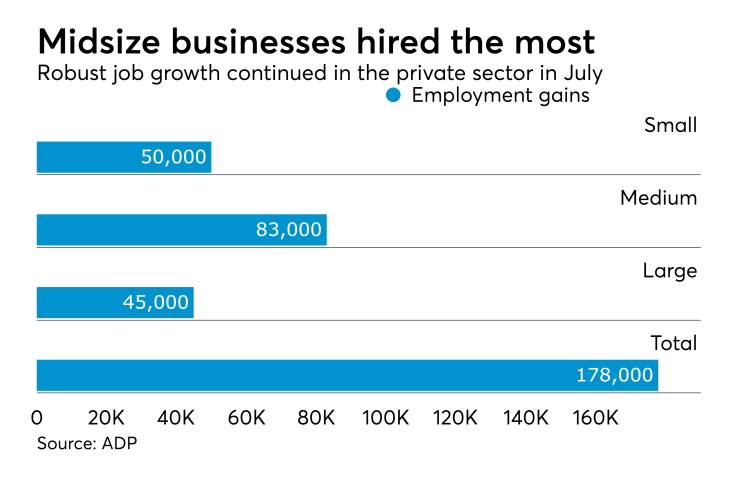Private sector employers created 178,000 jobs last month, according to payroll giant ADP, with gains seen in all sizes of businesses and most industries, except manufacturing.
Small businesses added 50,000 jobs last month, including 27,000 at businesses with between one and 19 employees and 22,000 at businesses with between 20 and 49 employees. Midsize businesses with between 50 and 499 employees added 83,000 jobs in July. Large businesses gained 45,000 jobs, including 35,000 in companies with between 500 and 999 employees, and 10,000 in organizations with 1,000 employees or more.
The service-providing sector added 174,000 jobs, including 65,000 in professional and business services, which includes accounting, tax preparation and other services. The financial activities sector added 13,000 jobs.
The goods-producing sector added 4,000 jobs. However, while the construction industry gained 6,000 jobs and the natural resources and mining industry added 3,000 jobs, the manufacturing industry lost 4,000 jobs.

“It was another solid month for the job market,” said Mark Zandi, chief economist at Moody’s Analytics, which compiles the monthly
However, ADP and Moody’s are seeing an impact on wage growth and productivity growth as the workforce ages and Baby Boomers remain working.
“Our sense of it is that the aging of the workforce is subtracting at least a quarter point per annum from wage growth and productivity growth, and at least half a point from wage and productivity growth,” said Zandi. “This is not going away. The aging of the Boomer cohort is going to continue for some time, at least over the next 10 to 15 years, so this aging weight upon productivity and wage growth will remain in place for a considerable period.”
For now, he doesn’t see any immediate impact from the tax reform and health care reform efforts in Washington.
“No change in policy on taxes and health care means no real impact on the economy or the labor market,” said Zandi. “It’s the status quo for the most part, assuming that the health care system doesn’t fall apart. Barring that, the status quo in policy means the status quo for the economy.”
However, he believes policymakers in Congress will soon need to pass a budget, or at least a continuing resolution, and raise the debt limit by early October or else the Treasury won’t be able to pay all its bills, which would be highly disruptive. “I would call that a cataclysmic result,” said Zandi.
Zandi does see some positive benefits from tax reform, though. “If they’re able to pass tax reform, which means lowering marginal rates and roughly paying for it, meaning don’t borrow money to pay for the tax cuts, that would be a plus for the economy,” he said. “Not next quarter or even next year, but over a decade or two, businesses would invest more, and that would add to productivity and potential economic growth. Also, if policymakers were able to address our convoluted corporate tax system around taxation of overseas earnings and move from a worldwide system to something that’s much more territorial, that also would be a plus.”





